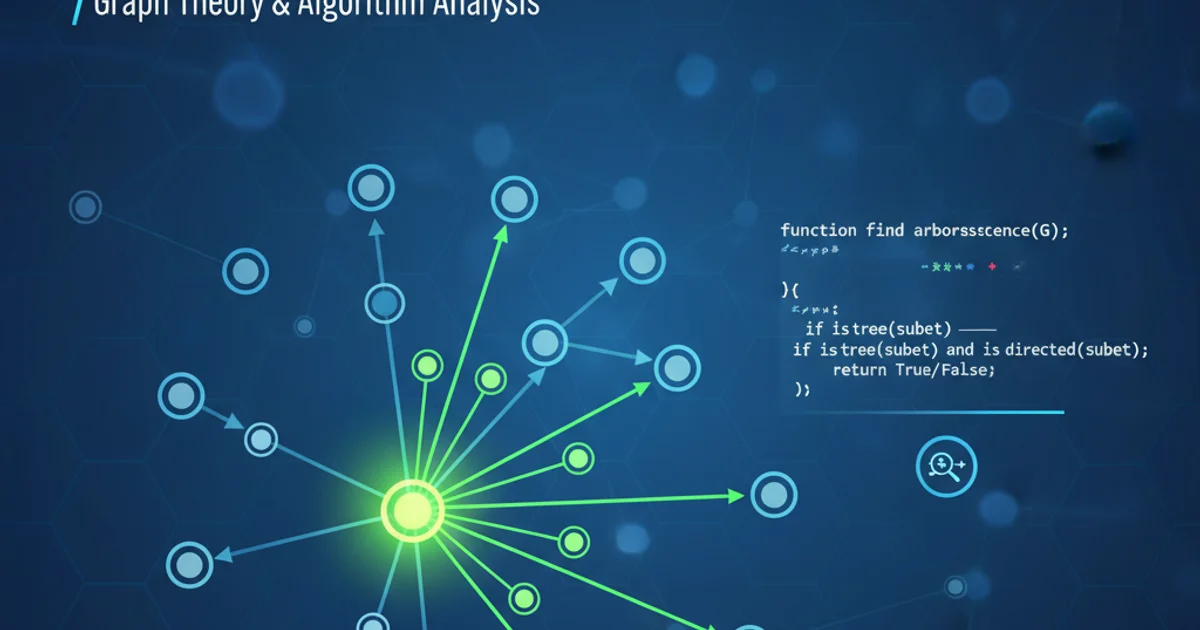algorithm to test whether G contains an arborescence
Categories:
How to Determine if a Graph Contains an Arborescence

Explore algorithms and conditions for identifying arborescences within directed graphs, a fundamental concept in graph theory with applications in network design and data structures.
An arborescence is a directed graph that is a directed tree, meaning it has a unique root node from which there is a unique directed path to every other node in the graph. Identifying whether a given directed graph contains an arborescence, and specifically, whether it is an arborescence, is a common problem in graph theory. This article delves into the conditions and algorithms required to make this determination.
Defining an Arborescence
Before we can test for an arborescence, it's crucial to understand its precise definition. A directed graph G = (V, E) is an arborescence if it satisfies the following properties:
- Root Node: There exists exactly one node, called the root
r, that has an in-degree of 0 (no incoming edges). - Unique Paths: For every other node
vinV(wherev ≠ r), there is exactly one directed path fromrtov. - Connectedness: The graph is weakly connected, meaning if you ignore edge directions, it forms a connected graph. More strongly, every node is reachable from the root.
- Number of Edges: If the graph has
nnodes, it must have exactlyn-1edges. This property is a direct consequence of the unique path requirement and the absence of cycles.
graph TD
subgraph Arborescence Properties
A["Exactly one root (in-degree 0)"]
B["Unique path from root to all other nodes"]
C["Weakly connected (all nodes reachable from root)"]
D["n nodes, n-1 edges"]
end
A --> E{Is G an Arborescence?}
B --> E
C --> E
D --> EKey properties defining an arborescence.
Algorithm for Arborescence Detection
To determine if a directed graph G is an arborescence, we can follow a systematic algorithm. This algorithm combines checks for the properties defined above:
- Identify Potential Roots: Iterate through all nodes to find nodes with an in-degree of 0. If there is not exactly one such node,
Gis not an arborescence. If there is exactly one, designate it as the rootr. - Check Edge Count: Count the total number of edges in
G. If the number of edges is not|V| - 1, where|V|is the number of nodes, thenGis not an arborescence. - Reachability and Unique Paths (DFS/BFS): Perform a Depth-First Search (DFS) or Breadth-First Search (BFS) starting from the identified root
r. During the traversal:- Keep track of visited nodes. If the traversal visits
|V|nodes, it means all nodes are reachable from the root. - Ensure that no node is visited twice via different paths from the root, which would imply a cycle or multiple paths. A simple way to check this is to ensure that when traversing an edge
(u, v),vhas not already been visited and is not the parent ofu(in the context of a tree traversal). For a directed graph, ifvis already visited, it indicates a cycle or multiple paths, violating the arborescence property.
- Keep track of visited nodes. If the traversal visits
If all these conditions are met, the graph G is an arborescence.
n-1 edge count is crucial for ensuring it's a tree structure without cycles, and the unique path property is implicitly checked by ensuring no node is visited twice during a traversal from the root.Example Walkthrough
Let's consider a small directed graph and apply the algorithm.
Graph G: Nodes: {A, B, C, D} Edges: {(A, B), (A, C), (C, D)}
Identify Potential Roots:
- In-degree(A) = 0
- In-degree(B) = 1 (from A)
- In-degree(C) = 1 (from A)
- In-degree(D) = 1 (from C)
Only node A has an in-degree of 0. So, A is our root
r.
Check Edge Count:
- Number of nodes
|V| = 4. - Number of edges
|E| = 3. |V| - 1 = 4 - 1 = 3. Since|E| = |V| - 1, this condition passes.
- Number of nodes
Reachability and Unique Paths (DFS from A):
- Start DFS from A.
- Visit A.
- From A, go to B. Visit B.
- From A, go to C. Visit C.
- From C, go to D. Visit D. All 4 nodes are visited. No node was visited twice via different paths, indicating unique paths and no cycles. All nodes are reachable from A.
Conclusion: Based on these checks, Graph G is an arborescence.
graph TD
A[A] --> B[B]
A --> C[C]
C --> D[D]Example graph G, which is an arborescence.